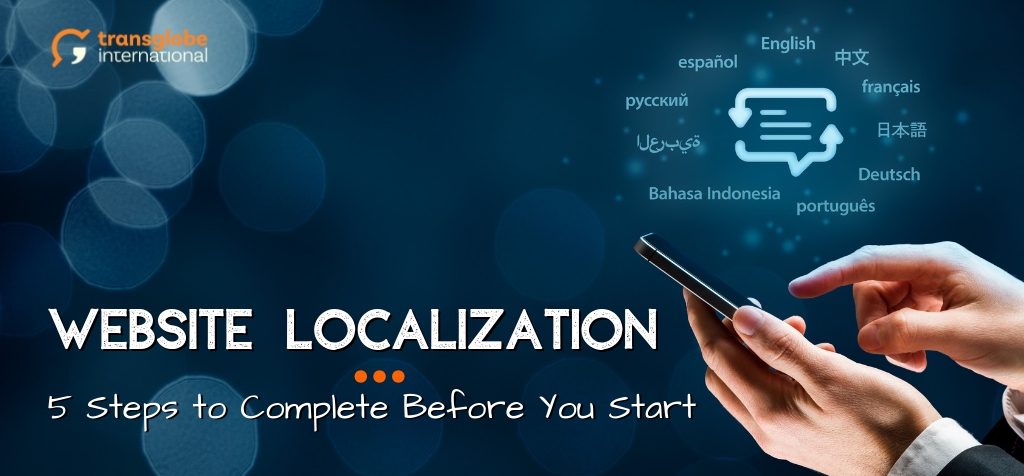Website Localization: 5 Steps to Complete Before You Start
Today more and more companies focus on providing web-based services or selling their products online. In our consumer-oriented world this means two things – a plethora of potential buyers and lots and lots of competition. To reach those buyers and stay ahead of competition, businesses have to prioritize website localization as part of their marketing strategy. It’s not enough to translate your homepage and contact page anymore. All your content should be optimized for each language your target audience speaks, considering the separate cultures, dialects, demographics. What is the right way to do this? Here are 5 things to check before making the decision:
(Step 1) Ensure you have access to your web content
The first thing you need to do is make sure you have the contacts or credentials for managing your company website and for access to the content files. Depending on various factors, you might only have the contacts of the webhosting provider, an old contract with a web design specialist or an in-house IT department. Regardless of this, you need to have the necessary correct details in order to change or update anything on your website. This may be as easy as sending an email to the right colleague, or in the worst case may require numerous phone calls, emails, recovering a lost account / password and even creating your website anew to an entirely new domain / website. So, if you need your website localized, make sure to check this first.
(Step 2) Specify and research target audiences
After ensuring you have access to your website’s back end and / or front end, it’s time to do some research. Based on your expansion plans you will need to specify the countries and target audiences and identify their needs regarding your products or services. This research should also include any competition you might encounter, as well as their market share, customer feedback, marketing activities, etc. Try to identify gaps in the supply or demand and estimate how well you can fill those gaps. As market research can be quite time-consuming and specialized, a good practice is to outsource it to a research agency or to consult with your localization company. This can save you a lot of time and effort before actually starting the localization process.
Website localization can signifficantly boost your online sales
Credit: TransGlobe International
(Step 3) Choose target languages based on priority and budget
Once you complete the research and analyze the results, you’ll need to select the target languages and prioritize them according to the desired results. Setting your budget may be tricky, especially if this is your first time doing a large-scale website localization. Essentially, this is relevant to your marketing budget, so try to dedicate a percentage of that to localization. There is no right answer, but according to this article (based on a CMO council report from July 2017) 75% of all marketers dedicate 10% or less of their budget for localization, while 63% are unsatisfied with their localization results. So a good starting point may be something between 10 and 20% of your marketing budget. However, always take your own budget and finances into consideration.
(Step 4) Identify and prepare website content for translation
Before moving forward with your website localization, you first may need to have your old content a bit cleaned-up, polished and up-to-date. This could mean anything from a a few changes here and there to a full overhaul of your website content and design. However, it is important to know your original content is error-free, SEO optimized and ready to be localized. It’s a good idea to compile a list of all your pages and corresponding keywords, so that this could be taken into account when optimizing your localized pages. Finally, identify the main pages you’ll have localized, making sure nothing important is left untranslated. You can use this step to find obsolete or unneeded content on your current website – leaving it clean, up-to-date and ready for localization.
(Step 5) Create glossary and style guide
With the first three preparation steps completed, you are now ready to get deeper into your content. You need to identify key terms in your content and create a multilingual glossary. After translating the glossary into all required target languages, your Language Service Provider can also compile a Corporate Style Guide for you. This includes various language rules and stylistic choices which reflect your corporate image, vision and brand. Always provide your LSP with both the Glossary and the Style Guide to ensure the optimal consistency of your localized content.
Website localization is an ongoing process
Once you have your original content localized in your desired number of languages, you’re done with the initial stage. From this point forward all you need to ensure is that your fresh content is localized into all selected languages as soon as possible. If you’re using a content management system (CMS) like WordPress or Joomla!, you can create user roles for your LSP with the required permissions. This will allow them to securely access your front end and translate new content or implement any changes as they come. What is left for you is to sit back and enjoy your new marketing tool to grow your business.
If you’re looking for a website localization partner, you are at the right place! We can help you reach the international markets and grow your business. Get in touch with us at hello@transglobeinternational.com for more information or use the button below to request a free quote!



Trackbacks/Pingbacks